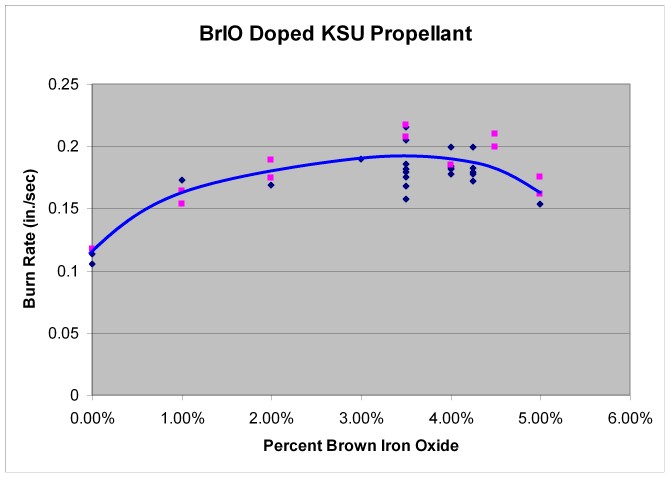|
|
Home ||
High Power Rocketry ||
Experimental Rocketry
Brown Iron Oxide Doped Propellant
and End (Port) Burning Rocket Motors
In my quest for a propellant
to make end burning motors, I tried brown iron oxide doped KNO3-sucrose
propellant because Richard Nacha reported unusually higher burn rates with
it. He thought it was an anomaly but finally decided his results were
valid. He only tested 1% BrIO and it was in KNO3-Dextrose propellant.
His final results discussion was that further testing with actual motors was
warranted but apparently he never did do that and went on to other projects.
So I decided to try other percentages and tested 1% to 5% and found that
3.5% was the optimal burn rate at atmospheric pressure. Like Richard,
I have left off still needing to do more testing which I plan to do when I
have a pressure test setup. I ended up with 38 separate burn tests at
atmospheric pressure. Actually there were more than that but some either
burned down one side faster than the other or was obscured by the smoke and
I wasn't able to get accurate times. The spread of the data was a
little disappointing. I was hoping to have more consistent tests.
That is why I kept running more and more tests. Nevertheless, a curve
emerged that I think is useful in determining what ratio of doping oxide is
probably optimal. some of the tests used 1/4" diameter, 3" test
strands with no OD inhibitor and others used a .8" diameter, 1.38" long
grains with an OD inhibitor (a standard grain cast in a 3/4" nominal pvc
pipe). I used a digital video recorder to determine the burn time.
If you look at Richards graph, fig 3 on
http://www.nakka-rocketry.net/oxidex.html, you can see how much faster
the burn rate is. You can also see that there wasn't much difference
at atmospheric pressure so without the elevated pressure tests, there is no
way to know how the different percentages of BrIO would actually perform in
a motor.
Here are the test results plotted.

I made three test motors and tested them. They were tested with 1%
BrIO before I decided to test what percentage would be best. I didn't
get to further motor tests with the higher percentage because another motor
I tested after these cato'd, damaged my test fixture and I didn't get it
repaired before I left off testing. (Got a new job and didn't have
much time anymore). They were single grain (obviously) and used three
different throat diameters. Here is the data on them.
| |
| Motor nominal size: |
3/4" pvc pipe |
|
Grain dia: |
0.80" |
| Grain length |
1.38" |
| Motor Test #1 |
|
| Nozzle Throat Dia |
1.41" |
| Thrust Duration |
1.53 sec |
| Maximum Thrust |
3.7 lb |
| Average Thrust |
1.63 lb |
| Total Impulse |
11.26 N-sec |
| Specific Impulse |
62.5 sec |
| Motor Classification |
very low "D" |
| |
|
| Test Motor #2 |
|
| Throat Dia |
0.125" |
| Maximum Thrust |
> 12.4 lb |
| Thrust Duration |
0.617 sec |
| |
|
| Test Motor #3 |
|
| Throat Dia |
0.109" |
| Maximum Thrust |
> 9.1 lb |
| Thrust Duration |
0.967 sec |
|
The first
motor was successful although not very efficient. It had the largest
diameter throat. The second and third tests used smaller (1/64"
increments) nozzles. Both over pressurized and found an alternate
path other than the nozzle. The gases formed passages on the outside
of the nozzles. In addition, before the leaks, the thrust was so
much higher than I expected that it topped out the recording amplifier and
cut off the top of the thrust curve. This also threw out the
calibration of my test fixture. The thrusts indicated were the
maximum recorded but the actuals could have been double or more.
Clearly, the nozzles were too small. BrIO doped propellant has a
steep slope on the calibration curve which means that for a given amount
of pressure increase, there is an above normal increase in burn rate which
further increases the pressure and so on so that you can get a runaway
pressure. That is why the last two tests leaked. It is
interesting that neither the nozzle nor header were ejected nor did the
case rupture. I calculated the pressure in the second two tests to
be probably 1000 psi or more max. My design pressure was 300 psi. |
Video
clip of successful end burner motor firing. .mpg format, 3 megs
Video
clip of a typical grain test. .mpg format, 2.4 megs
Home ||
High Power Rocketry ||
Experimental Rocketry
|
|
